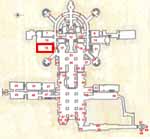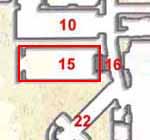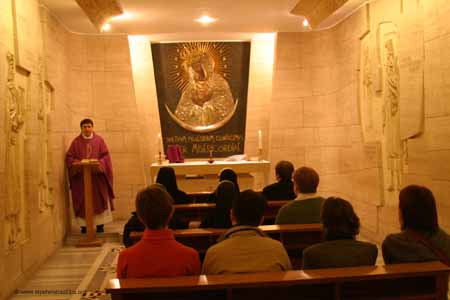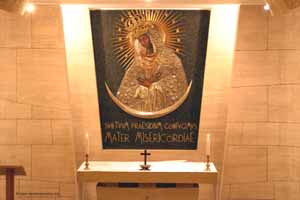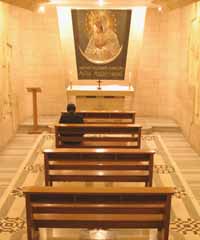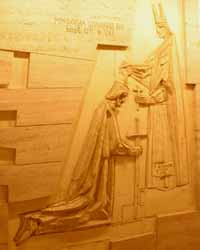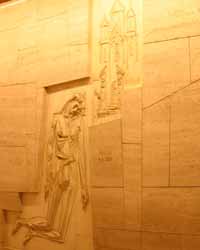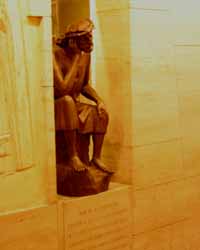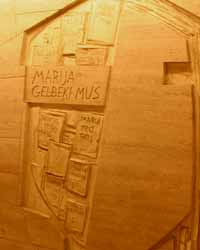| Grottoes
Vatican City Colonnade Saints Floorplan #2 |
| Altars
Monuments The History |
|
Related Links |
|
The story of this chapel, located next to the chapel of Partorienti, started on May 5, 1967. Bishop Vincent Brizgys, auxiliary of Kaunas (Lithuania) but resident in Chicago, in the name of the Lithuanian nationals scattered in different countries asked to create in the grottoes a chapel dedicated to Mary Mater Misericordiosa, venerated in Vilnius since 1570, especially in the imposing gate of the city called Gate of Aurora, dedicated to the memory of the Lithuanians martyred for their faith and for their country. |
|
|
|
|
|
|
|
|
|
|
|
|
|
|
|
|
|
Thanks to the good offices of His Eminence Baron Di Giura, ex-ambassador of Italy in Lithuania and of Cardinal Antonio Samore, on July 28 of the following year, Paul VI accepted the request. It was decided to build the chapel at the beginning of the peribolos, between the entrance to the pier of St Andres and the chapel of Partorienti. In order to create the necessary space, excavations were conducted through the wall of the peribolos into the area that during the Renaissance had been filled with earth to level the floor of the basilica. During the excavations which ended in autumn 1968, a number of discoveries were made. First of all, a decorated corridor of Paul V (1617) was found. It had been built before Bernini modified the area and then was filled in. The upper part of a stairway was found that during the construction of the basilica linked the higher level of the southern transept with the original lower level of the nave. Under the floor level of the old basilica they found 9 a cappuccina tombs and 3 marble sarcophagi. The chapel was decorated according to the artistic taste of the time but in harmony with the chromatic tonality and the simplicity of the grottoes. The figures and the ornaments have a distinct Lithuanian character. The chapel and the decoration were designed by Prof. Vytautas Jonyas, a Lithuanian artist living in New York, where the bas-reliefs were made. The work was executed by the Fabbrica di San Pietro under the supervision of Eng. Francesco Vacchini. |
||||||
|
The chapel was inaugurated on July 7, 1970. The night before, the altar was consecrated by Cardinal Paolo Marella, the Arch-priest of the Vatican basilica. The following morning, Pope Paul VI, in the presence of some 500 Lithuanian pilgrims from different parts of the world, blessed the chapel and the image of "Mater Misericordiae" and then celebrated Mass at the main altar of the grottoes. The image of the Vergine lituana placed on the back wall, dominates over the chapel. Below is the inscription: SVB TVVM PRAESIDIVM CONFVGIMVS MATER MISERICORDIEA (Under your protection we take refuge, Mother of Mercy). The work in mosaic was realized by the Studio of the Fabbrica di San Pietro. The silver facing forming the crescent and the cloak of the Madonna, the crown and the rays around her head, was made by Angelo Bortolotti from Rome. The altar faces the congregation. It is made from a single block of travertine with the Lithuanian cross on the frontal. The walls of the chapel are decorated with uneven, rough travertine slabs symbolizing the painful history of the Catholic Church in Lithuania. The white stucco bas-reliefs represent some of the most significant personages and events in the ecclesiastic life of Lithuania. To the left from the entrance is the baptism of Mindaugas in 1251, crowned as the king of the new Catholic people by Innocent IV. To the side from the entrance is the coat-of-arms of the pope by Pasquale Sciancalepre. Next is the symbolic view of the churches built in Vilnius and Kaunas by King Alexander Vyatautas (d.1430) in the 14th and 15th centuries. Next is the figure of Vladislaus Jogaila (d.1434), another evangelizer of Lithuania. Opposite, on the right wall, is the representation of San Josaphat Kuncevitius the Bishop (1580-1623), martyred for the unity of the church of Rome; and St Casimirus Patronus Primarius Lithuaniae (1458-1484). Next is the image of the church in Kraziai with the date A.D. 1893, when the Russian soldiers killed the faithful defending the church from being closed by the Tsar. The figure of the succumbing youth symbolizes the suffering of the Lithuanian people during numerous persecutions. Then is the half-finished profile of a young girl, the other half is formed by 12 title pages, in 12 different languages, of a prayer book called "Save Us Mary" that became very famous because it was written by 4 girls exiled in Siberia for their faith. On this figure is the only inscription in Lithuanian in this chapel: MARIJA, GELBEKI MUS (Mary, save us), To the right from the entrance is the coat-of-arms of Paul VI (by Pasquale Sciancalepre), who granted to the Lithuanian faithful the privilege of this sacred space in the grottoes. The chapel has a monochrome tonality enlivened by the grand image of the Madonna and by the artistic paving that appears like a polychrome carpet with a geometrical design, typical of the Lithuanian art. Among the precious marbles used to decorate the floor is serpentino and porphyry. In the left wall, close to the entrance, is an opening where ancient architectural elements are visible. This is a section of the original corridor leading to the sacred grottoes. Still visible, are some of the frescoes by Giovanni Battista Ricci da Novara (1617): fake marble with geometrical patterns, while on the vault is the fresco of the Cross and the symbols of the Passion together with decorative motifs, similar to the ones found in the peribolos. The bronze figure of Christ called Rupintojelis or Provider, is very dear to the Lithuanian tradition. The statue is the link between the ancient space and the modern chapel. The exhausted Christ is sitting on a rock, with his face resting on His forearm, in an attitude of silent suffering. The work was made by Alcide Tico after thorough studies of analogous Lithuanian models. The sacred space of the chapel is enclosed behind an artistic iron gate by Alfiero Nena. In the center is the ancient coat of arms of Lithuania with the figure of the white knight called "Vjtis". The gate is decoreated with iron plants and flowers from the Lithuanian symbology with the tulip (youth), rue (innocence), pine (majesty) and oak (strength). |
||||||
| Source: Roma Sacra The Vatican Grottoes, © Fabbrica of St. Peter's, June 2003 |
This independent website is not endorsed by or associated with the Vatican, the Fabbrica of St. Peter's, or any business organization
Contact:
stpetersbasilica@gmail.com
